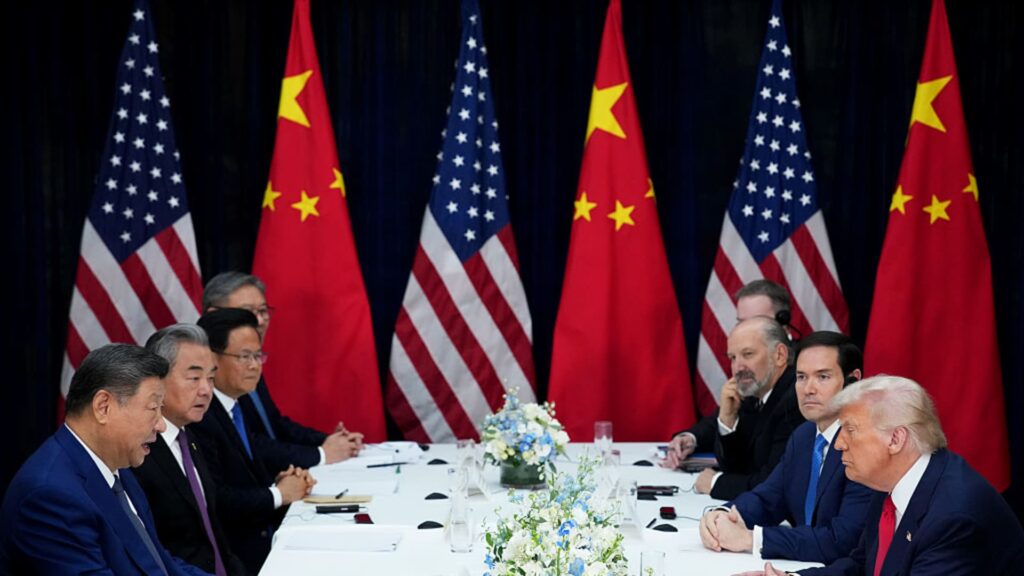BUSAN, South Korea – October 30: U.S. President Donald Trump (R) speaks with Chinese President Xi Jinping during bilateral talks at Gimhae Air Force Base in Busan, South Korea, October 30, 2025.
Andrew Harnik | Getty Images News
Following a high-stakes meeting in South Korea between U.S. President Donald Trump and Chinese President Xi Jinping, Beijing on Thursday suspended rare earth export controls, while the U.S. government lowered fentanyl-related tariffs.
The Chinese Ministry of Commerce announced that China’s export restrictions announced on October 9 will be postponed by one year, while the United States will similarly postpone the implementation of measures announced on September 29 that extend restrictions on blacklisted companies to their majority-owned subsidiaries.
President Trump told reporters on Air Force One as he left South Korea that his meeting with Xi was “great” and that “a lot of decisions were made.”
“The rare earth issue is resolved,” President Trump said, adding that it was a one-year agreement and would be negotiated annually. President Trump said tariffs on fentanyl would be reduced from 20% to 10%, effective immediately, and tariffs on Chinese exports would be reduced from 57% to 47%.
In return, the Chinese government will “do its best to stop fentanyl” and resume purchasing U.S. soybeans and other agricultural products.
Chicago Exchange soybean futures fell 1.6%, while China’s CSI Rare Earths Industry Index rose more than 2%, according to LSEG data.
Regarding Nvidia’s chip sales to China, President Trump said the two countries had discussed “a lot of chips” but not the cutting-edge Blackwell chip. “They’re going to talk to Nvidia and others about taking back the chips,” he said.
President Trump said Taiwan was not part of the discussion.
The U.S. decision to reduce fentanyl-related tariffs to 10% addresses “China’s significant grievances,” said Han Sheng Lin, China director at advisory firm Asia Group, and shows that “China’s efforts to curb exports of fentanyl precursors, long disapproved by the U.S. government, are finally being recognized.”
President Trump said he would visit China in April and that President Xi would then visit the United States, but the Chinese side did not provide a schedule.
The results of the talks announced so far by President Trump have “exceeded expectations,” in part because of the personal diplomacy of the two leaders that was strong enough not only to prevent escalation but to bring about an unthinkable outcome, said Alfredo Montufar Hell, managing director of Ancra Consulting’s Greenpoint business.
However, he added that friction will not be completely resolved as several bilateral issues at the heart of the US-China conflict remain unresolved.
It was the first meeting between Trump and Xi in six years, and the meeting lasted one hour and 40 minutes.

In a statement published by Chinese state media Xinhua News Agency after the meeting, Xi called for “dialogue rather than confrontation” and urged both sides to maintain regular working-level communication. According to CNBC’s translation of the Chinese statement:
The statement said the two sides agreed to strengthen cooperation on trade, energy and economic issues, and to promote cultural and people-to-people exchanges.
While the trade ceasefire is “welcome news,” there is no sign that it will address fundamental structural concerns such as China’s industrial overcapacity and non-market economic practices, said Wendy Cutler, senior vice president at the Asia Society Policy Institute.
That means the ceasefire is “fragile and tensions are certain to rise again,” Cutler added.
“Partners and Friends”
Before the meeting, the two leaders struck a conciliatory tone, with Trump calling Xi an “old friend” with whom he had a “very good relationship” and Xi stressing that China’s economic growth ambitions would not undermine Trump’s vision of “making America great again.”
Tensions between the world’s two economic powers have boiled over this year. The latest escalation occurred this month, with the Chinese government’s export restrictions and the US government’s threat to ban software exports to China.
The United States has been sharing details in recent days of deals it hopes to reach with China, ranging from limiting the flow of fentanyl into the United States to selling TikTok from its Beijing-based parent company ByteDance. Tariffs, technical regulations, and rare earths were also on the table for discussion.
Beijing has been more cautious about the prospects for a deal, but in a sign that relations may end, China has bought its first cargo of U.S. soybeans in months, Reuters reported on Wednesday.
Prior to the meeting, Mr. Xi shook President Trump’s hand during a photo shoot at Gimhae Air Base in Busan, and in his opening remarks appealed for the United States and China to become “friends and partners.”
The Chinese leader, sitting across the table from Trump, said he was “very happy” to have met the US president for the sixth time, adding that it was “normal” for the two economic powers to have “sometimes friction”.
“China’s development is closely related to your vision of making America great again,” Xi said, according to a statement from China’s Ministry of Foreign Affairs.
Yue Su, chief economist at the Economist Intelligence Unit, said the conciliatory tone marked a marked change from Xi’s talks with former US President Joe Biden late last year, in which he further emphasized the “inevitable competition” between the two countries.
Although the deal still lacks “solid structural foundations” and could be easily overturned, the two countries are likely to stick to it in the short term to demonstrate friendly relations, Su added.

